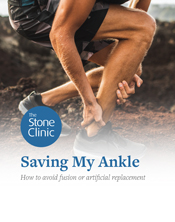Ankle Pain Diagnosis Symptom Checker
If you’re not sure what might be wrong with your ankle, our self-diagnosis tool is a good place to start.
It won’t replace a real doctor and cannot give a definitive diagnosis but it may help you better understand your symptoms.
1
Select your injury body area & symptom(s) below
2
Select from list of possible conditions
Disclaimer: This tool is for information purposes only and provides only an approximate guide as to what may be wrong with your joints. It should not be used instead of seeking professional medical advice or diagnosis.
Live in the San Francisco Bay Area?
Call for information or to book an appointment to see us in person
Outside of the Bay Area?
If, like many of our patients, you don't live in the Bay Area, we offer a complimentary phone consultation service.

Why Does My Ankle Hurt?
If you are experiencing ankle pain or swelling from a recent injury, ankle pain while walking or running, or ankle pain while resting, etc., it may be a minor concern or indicator of a serious issue.
Ankle pain is usually caused by traumatic injuries, repetitive motion injuries, long-term wear & tear, or tissue disorders. Below are injuries that are common causes for ankle pain, but it is best to enter your symptoms into our Ankle Pain Diagnosis Symptom Checker to gain a better understanding of your injury and read orthopaedic surgeon Kevin R. Stone MD's blog article on ankle pain and when you should consider surgery.
Common Ankle Injuries
- Achilles tendon injury: the Achilles is a dense band of tissue that passes behind the ankle joint. Injuries to it vary from mild to severe: tendonitis, a partial rupture, or complete rupture. A complete rupture is debilitating, can cause immense pain, and requires immediate medical/surgical intervention to avoid permanent tissue damage.
- Ankle fracture: a foot twist can sometimes cause bones to break. Even minor displacements can cause a significant increase in the abnormal forces across the joint, eventually leading to arthritis. Treatment is based on the fracture pattern and the degree of displacement. Accuracy in diagnosis is key to determining the best course of treatment.
- Ankle arthritis/cartilage injury: is characterized by cartilage damage that, over time, causes cartilage lesions on the weight-bearing surface of the ankle joint resulting in symptomatic pain, inflammation, swelling, and stiffness. These symptoms may be experienced years after an ankle injury occurred.
- Ankle sprain: sprains are very common but they are usually minor and heal quickly. There are three grades of sprains:
- Grade I: stretching of the ankle ligaments without tearing of the collagen fibers.
- Grade II: partial tearing of the ankle’s collagen fibers without a complete rupture.
- Grade III: complete rupture of the ankle’s collagen fibers.
- Plantaris rupture: the Plantaris muscle is a fine rope-like tendon running next to the larger Achilles Tendon. A tear or rupture of this muscle is commonly called “Tennis Leg” and is usually the result of a sudden muscular action such as reaching out for a tennis shot. Patients often report hearing a pop in the back of their calf at the time of injury accompanied by pain and swelling most commonly at the junction of the calf muscle and the Achilles tendon, the location of the rupture.
Ankle Injury Diagnosis Chart
The ankle injury charts below provide an approximate guide as to which part of the anatomy may be injured based on the location of your ankle/foot pain. They are for informational purposes only and should not be used instead of seeking professional medical advice or diagnosis.




